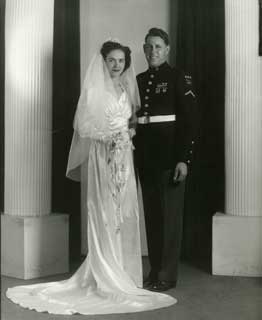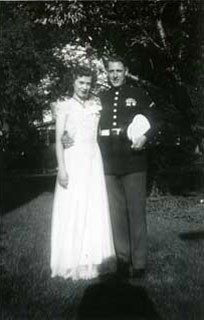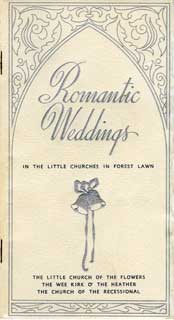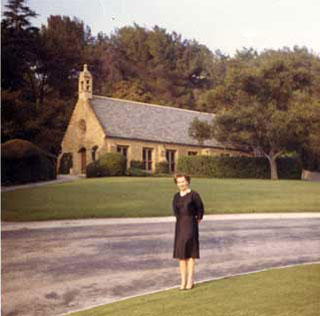Doris Shea Strand: Cemetery Wedding
Life was lived in the moment for young Americans during the uncertain years of World War II. Wartime romances were often short-lived and intense. Sweethearts rushed into marriage as young men marched off to fight, and single girls on the home front bemoaned the shortage of "good men." A lasting relationship might spring from a single dance at the U.S.O. or, as in the case of Doris Shea Strand, through a letter. Ms. Strand was interviewed by Thomas Saylor in 2002 for his book, Remembering the Good War, and remembered how she met her husband, Errol Fox, and their unusual wedding.
Audio
Transcript
DS: We did an awful lot of letter writing to the service people, because that was one way that almost everybody could contribute to making them feel a little more comfortable and know that we cared. A group of seven Marines who were stationed at Camp Elliot in San Diego wrote to the Los Angeles paper on the editorial page saying that they were lonesome and wanted to write to someone. They hoped that some ladies or young girls could write to them. My girlfriend's aunt clipped it out and sent it back to us in Minneapolis. So, we thought, "Oh, boy, we'll do this." I always had a soft spot in my heart for an Irish name so I wrote to a [guy named] Kelly. As it turned out, they got bags and bags of mail and the sergeant out there saw that they were not lonesome and didn't have anything to do, because he expanded their K.P. duties or whatever. At any rate, this Kelly was going through all the mail he received and he said, "Well, Fox, Errol Fox, this gal lives in your hometown." So at that point Errol Fox started to write to me. We corresponded for a couple years, just very generic.
Then I didn’t hear from him for a long time. I assumed that he was dead or just didn't care to write any more. My mother still encouraged me to write to him. "You don't know what he's going through. You just write a few more letters."
Part of the war effort, you know. We had to do all these things. But anyhow, in June of 1944 the family was having a quick supper so we could go to a wake for a family friend. The phone rang and a young man was asking me to a party. I insisted I didn't go with anybody I didn't know, so I hung up. Well, he kept calling back, and I hung up on him three times. On the fourth call he finally identified himself and I about fainted, I think.
TS: Because you had never met him before?
DS: Oh, no. No, strictly a mail order, mail friendship. At that point he said he was coming over, and all of a sudden we didn't care about going to the wake for Mr. Perry. [Laughs] The whole family wanted to see who this joker was.
TS: Did they know he was a Marine?
DS: Oh, yes. All of a sudden we saw this car go by with this fellow in a Marine dress uniform, his blues. Of course, he drove right by the house, and my Daddy goes out on the curb and flags him down like he'd had a spinster in here he had to get rid of! [Laughs] I was so embarrassed. Anyhow, he came in, and we got acquainted. That was June 4th. On June 16th I got a diamond, and in December of that year - we had set up a wedding day for October 21st but his transfer didn't come through. He was supposed to be transferred to North Platte, Nebraska and instead he was sent to Camp Pendleton, California with no leave. So we had to cancel the wedding and I went to California then. I got there Christmas Day of 1944, and on December 27th we were married in Forest Lawn Cemetery at 9:30 at night.
TS: You have to explain that. Getting married in the cemetery at 9:30 at night!
DS: Some former neighbors of the Foxes met us at the station. We went out on the train. Errol's mother went with me. We didn't know what to do. He had a three-day pass. We didn't have any church connections or anything, but I remembered a fellow from our home church had a parish in La Crescenta, California. So this Mr. McMurtry called around and he said, "How about Forest Lawn?" So we got married in the Wee Kirk of the Heather, which was a replica of Annie Laurie's church in Scotland. We arranged to have twenty-two people there, various people. Everybody couldn't come because of gas rationing and it was out of the way. I had taken my wedding dress that had been scheduled to be used in October. I had taken it along, so we had a little wedding at 9:30 at night, and it [the marriage] lasted for forty-some years.
TS: Why was the wedding at night?
DS: Forest Lawn had a ruling at that time, that they had funerals every hour during the day. Starting at 5:30 they had weddings on the hour. So 9:30 was the last appointment of the day and it was the only vacancy they had. That's why we took it.
TS: So these one-hour spots were scheduled? Were a lot of servicemen taking advantage of this?
DS: Evidently. They were booked.
Source
Strand, Doris Shea; Thomas Saylor, Interviewer, Minnesota's Greatest Generation Oral History Project, Thomas Saylor; Minnesota Historical Society Oral History Collection, 2002.






